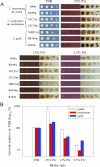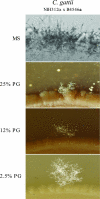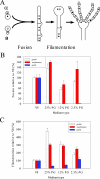Cryptococcus neoformans mates on pigeon guano: implications for the realized ecological niche and globalization
- PMID: 17449657
- PMCID: PMC1951517
- DOI: 10.1128/EC.00097-07
Cryptococcus neoformans mates on pigeon guano: implications for the realized ecological niche and globalization
Abstract
The ecological niche that a species can occupy is determined by its resource requirements and the physical conditions necessary for survival. The niche to which an organism is most highly adapted is the realized niche, whereas the complete range of habitats that an organism can occupy represents the fundamental niche. The growth and development of Cryptococcus neoformans and Cryptococcus gattii on pigeon guano were examined to determine whether these two species occupy the same or different ecological niches. C. neoformans is a cosmopolitan pathogenic yeast that infects predominantly immunocompromised individuals, exists in two varieties (grubii [serotype A] and neoformans [serotype D]), and is commonly isolated from pigeon guano worldwide. By contrast, C. gattii often infects immunocompetent individuals and is associated with geographically restricted environments, most notably, eucalyptus trees. Pigeon guano supported the growth of both species, and a brown pigment related to melanin, a key virulence factor, was produced. C. neoformans exhibited prolific mating on pigeon guano, whereas C. gattii did not. The observations that C. neoformans completes the life cycle on pigeon guano but that C. gattii does not indicates that pigeon guano could represent the realized ecological niche for C. neoformans. Because C. gattii grows on pigeon guano but cannot sexually reproduce, pigeon guano represents a fundamental but not a realized niche for C. gattii. Based on these studies, we hypothesize that an ancestral Cryptococcus strain gained the ability to sexually reproduce in pigeon guano and then swept the globe.
Figures





Similar articles
-
Quantitation of Purines from Pigeon Guano and Implications for Cryptococcus neoformans Survival During Infection.Mycopathologia. 2019 Apr;184(2):273-281. doi: 10.1007/s11046-018-0315-0. Epub 2019 Feb 1. Mycopathologia. 2019. PMID: 30707338
-
Isolation, Identification and Molecular Typing of Cryptococcus neoformans from Pigeon Droppings and Other Environmental Sources in Tripoli, Libya.Mycopathologia. 2016 Aug;181(7-8):603-8. doi: 10.1007/s11046-016-9996-4. Epub 2016 Mar 4. Mycopathologia. 2016. PMID: 26943725
-
Geographic distribution of patients affected by Cryptococcus neoformans/Cryptococcus gattii species complexes meningitis, pigeon and tree populations in Southern Brazil.Mycoses. 2017 Jan;60(1):51-58. doi: 10.1111/myc.12550. Epub 2016 Aug 26. Mycoses. 2017. PMID: 27561904
-
Environmental prevalence of Cryptococcus neoformans and Cryptococcus gattii in India: an update.Crit Rev Microbiol. 2012 Feb;38(1):1-16. doi: 10.3109/1040841X.2011.606426. Epub 2011 Dec 1. Crit Rev Microbiol. 2012. PMID: 22133016 Review.
-
[Cryptococcosis caused by Cryptococcus neoformans var. Gattii. A case associated with acquired immunodeficiency syndrome (AIDS) in Kinshasa, Zaire].Med Trop (Mars). 1992 Oct-Dec;52(4):435-8. Med Trop (Mars). 1992. PMID: 1494313 Review. French.
Cited by
-
An evolutionary genomic approach reveals both conserved and species-specific genetic elements related to human disease in closely related Aspergillus fungi.Genetics. 2021 Jun 24;218(2):iyab066. doi: 10.1093/genetics/iyab066. Genetics. 2021. PMID: 33944921 Free PMC article.
-
Many globally isolated AD hybrid strains of Cryptococcus neoformans originated in Africa.PLoS Pathog. 2007 Aug 17;3(8):e114. doi: 10.1371/journal.ppat.0030114. PLoS Pathog. 2007. PMID: 17708680 Free PMC article.
-
The mycobiome of Australian tree hollows in relation to the Cryptococcus gattii and C. neoformans species complexes.Ecol Evol. 2019 Aug 7;9(17):9684-9700. doi: 10.1002/ece3.5498. eCollection 2019 Sep. Ecol Evol. 2019. PMID: 31534685 Free PMC article.
-
Purine Acquisition and Synthesis by Human Fungal Pathogens.Microorganisms. 2017 Jun 8;5(2):33. doi: 10.3390/microorganisms5020033. Microorganisms. 2017. PMID: 28594372 Free PMC article. Review.
-
A New Lineage of Cryptococcus gattii (VGV) Discovered in the Central Zambezian Miombo Woodlands.mBio. 2019 Nov 12;10(6):e02306-19. doi: 10.1128/mBio.02306-19. mBio. 2019. PMID: 31719178 Free PMC article.
References
-
- Abou-Gabal, M., and M. Atia. 1978. Study of the role of pigeons in the dissemination of Cryptococcus neoformans in nature. Sabouraudia 16:63-68. - PubMed
Publication types
MeSH terms
Grants and funding
LinkOut - more resources
Full Text Sources
Other Literature Sources
Medical

